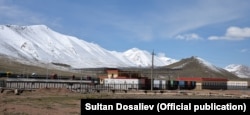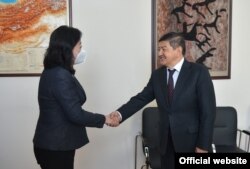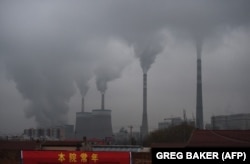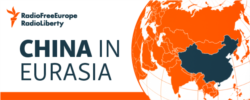
For more than 18 months, pandemic-related restrictions introduced by China along its border with Kyrgyzstan have seen cross-border commerce dwindle and left the truckers and businesses who rely on the shuttle trade desperate for a financial lifeline.
Now, a new system proposed by the Kyrgyz government to kick-start trade between the two countries has truck drivers who make their living ferrying cargo across the border worried that prohibitive added costs could leave them squeezed even further.
"This scheme will harm [truck drivers], private entrepreneurs, and the state, too," Maksatbek Duisheev, the chairman of the Saparman Truckers Association, told RFE/RL's Kyrgyz Service. "They say that this is a proposal needed to comply with the Chinese side, but we have not been shown an official document. The whole situation is not clear."
The proposed system has already sparked a backlash, with about 400 drivers gathering on November 8 in the Kochkor district of Kyrgyzstan's eastern Naryn region to protest the new measures and sending an open appeal to President Sadyr Japarov's office.
Trade with China makes up a crucial portion of the Kyrgyz economy, but since the start of the pandemic in 2020, imports from China to Kyrgyzstan have fallen by 57.5 percent, with the number of trucks crossing with cargo declining 10-fold.
Bishkek has been desperate to raise trade back to pre-pandemic levels, a goal that has been hampered by coronavirus concerns from Chinese authorities who require rigorous and time-consuming health procedures to cross the border.
In order to better comply with Chinese COVID regulations and increase the number of cargo trucks crossing the border, Kyrgyz officials plan to create a so-called "sanitary zone" near the border crossing by Torugart, where a designated number of trucks will ferry containers with goods from China across a neutral zone between the two countries and load them onto Kyrgyz freight trucks.
According to a proposal, this service will be provided by Silk Way, an industrial and logistics center built along the Kyrgyz-Chinese border that is largely funded by Chinese investors.
While the new system could lead to cargo traffic recovering from its pandemic slump, Nabir Toktorov, chairman of the Association of Carriers of Kyrgyzstan, fears that truckers will be left bearing the costs, which could result in inflation and a decrease in the total amount of freight traffic.
Under the proposed new rules, drivers could be charged a fee ranging from $1,000 to $1,500 per truck for this service, which could cut into already thin profit margins. Adding to the anxiety and confusion, full details of the arrangement have not been presented to Kyrgyzstan's various truckers associations.
"They say that this money will go to the budget. But I don't understand this. If this money will not be used to pay taxes or repair roads, then on the basis of what law will they collect $1,000?" Toktorov told RFE/RL's Kyrgyz Service. "This is a robbery!"
Kyrgyzstan's State Customs Service did not reply to requests for comment from RFE/RL.
Restarting Cross-Border Trade
China is one of the last countries in the world to continue with a strict "zero-COVID" policy, which sometimes entails locking down entire cities if a single case is detected.
These tough measures have corresponded with rigid border controls and restrictions on the types of people and goods that have been allowed to cross the Chinese border. In addition to Kyrgyzstan, cross-border trade with Kazakhstan and Tajikistan has also seen a precipitous drop over the course of the pandemic.
More so than its Central Asian neighbors, Kyrgyzstan's economy relies heavily on imports from China, especially for goods such as electronics, textiles, and construction materials.
The effects of the pandemic border rules by China were felt quickly in Kyrgyzstan. By the end of March 2020, shortages of Chinese imports began to appear in the country and Bishkek sent a note to the Chinese authorities to ease restrictions on cross-border cargo transportation.
"Our imports are 2 1/2 times higher than exports and most of the imports come from China," Askar Sydykov, the executive director of the Bishkek-based International Business Council, told RFE/RL's Kyrgyz Service. "Continuous work on the Kyrgyz-Chinese border is very important for the country's economy. Even raw materials for light industry come to us from China."
For drivers making the trip throughout the pandemic, health measures at the border have led to lengthy delays and cut into the bottom line of truckers and companies alike.
Complicated border procedures now consist of a time-consuming disinfection process for trucks and goods arriving from Kyrgyzstan -- as well as checks on the drivers themselves -- that has sent wait times soaring and limited the numbers of trucks able to cross on a given day.
Only after completion of this process, which drivers say can take more than 90 minutes, are trucks allowed to cross the border. Upon leaving Kyrgyzstan, the container on the truck is unhitched and replaced by a full container of Chinese goods and then drivers then begin the process of returning to the Kyrgyz side.
The proposed measures that drivers protested on November 8 are intended to speed up this process and eliminate the bottlenecks at the borders that have developed over the course of the pandemic, although drivers who spoke to RFE/RL's Kyrgyz Service said the new system could create new opportunities for graft.
Several also raised concerns that Silk Way was selected for the proposal given that Adilet Kubanychbekov, who was appointed as the new head of the State Customs Service in October, previously served as the director of the industrial and logistics center.
Bishkek And Beijing
Kyrgyzstan is grappling with a contracting economy whose gross domestic product dropped 8.6 percent in 2020 and has remained sluggish throughout the pandemic.
Due to China's economic importance, smoothing relations with Beijing and boosting economic activity with its large neighbor have been a priority of Kyrgyzstan's current government.
Akylbek Japarov (no relation to the president), the chairman of Kyrgyzstan's Cabinet of Ministers, has taken up this issue since assuming his new role on October 12, addressing it in parliament and visiting the Torugart checkpoint along the border, where he vowed to increase the number of trucks allowed to cross and find new ways to boost the state budget.
The official once again pressed ahead on trying to improve trade with China and attract more investment from the country when he met with Chinese Ambassador Du Dewen on November 9. "We need to increase trade. The Cabinet of Ministers is ready to guarantee the safety of investors," he said during his meeting with Dewen, according to an official readout.
For the time being, drivers continue to be frustrated, both over the cost and ambiguity of government efforts to increase cargo traffic and due to many border crossings still not being fully operational.
According to Temirbek Shabdanalivev, the head of the Association of Freight Forwarders of Kyrgyzstan, this has led to many truckers and others involved in the transport sector being out of work or underemployed.
"Many drivers have been left without work and not just them, either. It's their assistants and the loaders and logistics people as well," Shabdanalivev told RFE/RL. "Our drivers call and ask what to do, whether to stage a protest or not. They say that there is nothing to feed their families."















